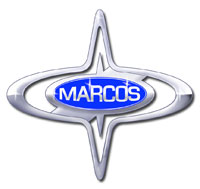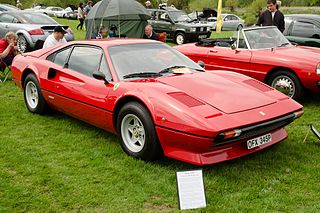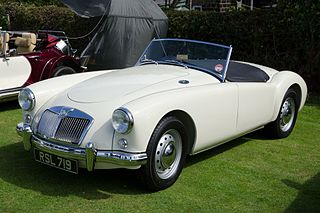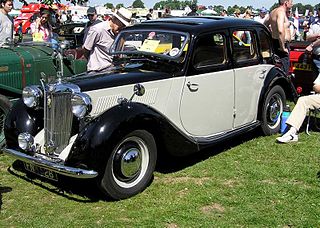Related Research Articles

Marcos Engineering was a British sports car manufacturer. The name derives from the surnames of founders Jem Marsh and Frank Costin.

The Caterham 7 is a super-lightweight sports car produced by Caterham Cars in the United Kingdom. It is based on the Lotus Seven, a lightweight sports car sold in kit and factory-built form by Lotus Cars, from 1957 to 1972.
Noble Automotive Ltd, more commonly known simply as Noble, is an English sports car manufacturer based in Leicester. Noble Automotive Ltd. was established in 1999 by Lee Noble in Leeds, West Yorkshire, for producing high-speed sports cars with a rear mid-engine, rear-wheel drive layout. Lee Noble was the chief designer and part owner of Noble. The company was sold in August 2006. He left the company in February 2008 and shortly after announced his new venture, Fenix Automotive in 2009.

FSO Warszawa is an automobile manufactured in FSO factory in Warsaw, Poland between 1951 and 1973, based on GAZ-M20 Pobeda.

The Ferrari 308 GTB berlinetta and targa-topped 308 GTS are V8 mid-engined, two-seater sports cars manufactured by the Italian company Ferrari from 1975 until 1985. The 308 replaced the Dino 246 GT and GTS in 1975 and was updated as the 328 GTB/GTS in 1985. The similar 208 GTB and GTS were equipped with a smaller, initially naturally aspirated and later turbocharged, two-litre engine, and were sold mainly in Italy.

The Morgan 4/4 is a British motor car which was produced by the Morgan Motor Company from 1936 to 2018. It was Morgan's first car with four wheels, the name indicating that the model has four wheels and four cylinders. Early publicity and advertising material variously referred to the model as "4/4", "4-4", "Four Four", and similar names, but from the outset the factory designation was always "4/4".

The MGA is a sports car that was produced by MG from 1955 until 1962.

The Morgan Aero 8 is a sports car built by Morgan Motor Company at its factory in Malvern Link, England from 2000 until 2018.

The MG Y-Type is an automobile produced by MG in England from 1947 to 1953. It was offered in four-door saloon and limited production open four-seat tourer versions.
Morris Cowley was a name given to various cars produced by Morris from 1915 to 1958.

The Chevrolet Corvette (C2) is the second-generation Corvette sports car, produced by the Chevrolet division of General Motors (GM) for the 1963 through 1967 model years.

The Austin Ten is a small car that was produced by Austin. It was launched on 19 April 1932 and was Austin's best-selling car in the 1930s and continued in production, with upgrades, until 1947. It fitted in between their "baby" Austin Seven which had been introduced in 1922 and their various Austin Twelves which had been updated in January 1931.

Dante Giacosa was an Italian automobile designer and engineer responsible for a range of Italian automobile designs — and for refining the front-wheel drive layout to an industry-standard configuration. He has been called the deus ex machina of Fiat.

The Lancia Appia is a passenger car introduced in 1953 by Italian car manufacturer Lancia as a replacement for the Ardea, and which remained in production for ten years. The Appia was the last in a long line of Lancia production cars dating back to the Lancia Lambda to use sliding pillar front suspension. All three series produced had a 1089cc Lancia V4 engine.

The Triumph Renown is strictly the name given to the Triumph's large saloon car made from 1949 to 1954 but it is, in reality, part of a three-car series of the 1800, 2000 and Renown models. Together with the Triumph Roadster, they were the first vehicles to carry the Triumph badge following the company's takeover by the Standard Motor Company.

The Daimler Regency series was a luxury car made in Coventry by The Daimler Company Limited between 1951 and 1958. Only an estimated 49 examples of the 3-litre Regency chassis were made because demand for new cars collapsed just weeks after its introduction. Almost three years later in October 1954, a lengthened more powerful Regency Mark II (DF304) was announced but, in turn, after a production run of 345 cars, it was replaced by the very much faster, up-rated One-O-Four (DF310), announced in October 1955.

The Vauxhall 30–98 is a car manufactured by Vauxhall at Luton, Bedfordshire from 1913 to 1927. In its day, its best-known configuration was the Vauxhall Velox standard 4-seater with open tourer body. Vauxhall's own description was the 30–98 hp Vauxhall-Velox sporting car. The 30–98 is also known to enthusiasts by Vauxhall's chassis code E.

The Ford Taunus G93A is a small family car that was produced by Ford Germany between 1939 and 1942 in succession to the Ford Eifel. It was the first car developed at Cologne by Ford Germany which previously had built cars originated by Ford businesses in the US or the UK. Production began on 30 April 1939, with the first car exhibited to the public in June 1939, less than six months before the outbreak of war in Europe.

The Reliant Scimitar SS1 is an automobile which was produced by British manufacturer Reliant from 1984 to 1995.

The Auburn Speedster is an American car, manufactured by the Auburn Automobile Company of Auburn, Indiana and manufactured in Union City, Indiana. A total of 887 cars were manufactured between 1928 and 1936, across 3 series. The first two series were designed by stylist Alan Leamy. The Auburn 851 Speedster of 1935 was styled by designer Gordon Buehrig, who also was responsible for the Cord Model 810. Al Jenkins broke 70 American speed records in the 1935 car.
References
- ↑ About Malaxa (in Romanian)